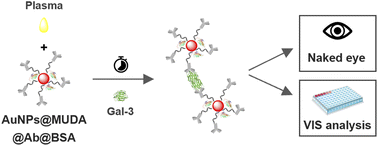Gold nanoparticle probes for colorimetric detection of plasma galectin-3: a simple and rapid approach†
Abstract
Galectin-3 (Gal-3) is a carbohydrate-binding protein associated with the development and progress of heart failure. Here, we report the first colorimetric and low-cost approach for detecting and quantifying Gal-3 using gold nanoparticles (AuNPs) bioconjugated with Gal-3 antibody. The interaction of Gal-3 with the resulting nanoprobes led to a linear response of the absorbance ratio A750nm/A526nm to Gal-3 concentration, accompanied by a change in color intensity. The assay showed a linear optical response even in complex samples, such as saliva and fetal bovine serum (FBS), up to a concentration of 200 μg L−1. The limit of detection (LOD) followed the trend LODPBS (10.0 μg L−1) < LODsaliva (22.6 μg L−1) < LODFBS (25.3 μg L−1). The potential applicability of this method to the analysis of human plasma samples was also demonstrated. Compared to conventional detection techniques, this colorimetric assay provides faster results (∼1 h) and is more cost-effective due to the use of simple and unexpensive equipment. This assay represents an exciting solution for the rapid screening of high risk for rapid progression of heart failure in patient samples (Gal-3 > 25.9 μg L−1).



 Please wait while we load your content...
Please wait while we load your content...